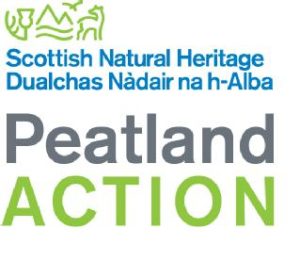 A fifth of Scotland is peatland. Healthy peatlands with high groundwater levels are crucial for trapping carbon – essential for Scotland to meet its emissions reduction target of 42% by 2020.
A fifth of Scotland is peatland. Healthy peatlands with high groundwater levels are crucial for trapping carbon – essential for Scotland to meet its emissions reduction target of 42% by 2020.
It is vital to ensure that peatlands remain effective as an emissions sink. Scotland’s peatlands store 25 times more carbon than all other plant life in the UK, while degraded soils emit carbon.
Scottish peatlands also reduce the downstream impacts of flooding, provide fuel for rural communities and are internationally recognised as a habitat for wildlife. They need protection.
In 2012, Scottish Natural Heritage (SNH) launched to restore damaged, degraded or destroyed peat soils and reduce carbon emissions.
The key is to maintain the groundwater level within a few centimetres of the surface through:
- Blocking ditches to directs water back into peat soils.
- Bunding to block sub-surface cracks that leak water out of peat soils.
- Reprofiling exposed peat by smoothing trench slopes and covering with topsoil vegetation.
- Surface smoothing by ‘stump flipping’ old trees into the peat then smoothing the ground.
Time for WHS
WHS needed to assess the effectiveness of the projects in restoring the hydrology of the peatland.
Working in remote environments and in harsh weather conditions, we installed and surveyed 16 new groundwater level sites and four rainfall monitoring sites, and refurbished existing sites.
- We selected new station locations to ensure that improvements in water levels resulting from peatland restoration techniques could be detected.
- We maintained existing installations where necessary and downloaded water-level data.
- We checked the quality of data and resolved any issues.
We monitored 65 sites and quality-assured the data from them all. Issues that we needed to remedy included:
- Some existing installations were providing incorrect data.
Data loggers had been installed too low in the soil, letting water into the siting well and damaging the devices. Where possible, we repositioned the siting wells. - Some data loggers had not been initialised correctly.
Unnecessary parameters had been selected, resulting in incorrect data and reduced battery life. We reprogrammed the loggers.
Result: The Peatland ACTION project has been shortlisted for three awards at the Chartered Institute of Ecology and Environmental Management (CIEEM) for high standards of environmental management practice, providing major benefits to wildlife conservation and restoring the natural environment. The project’s positive impact on the landscape of Scotland will hopefully be recognised across the UK.